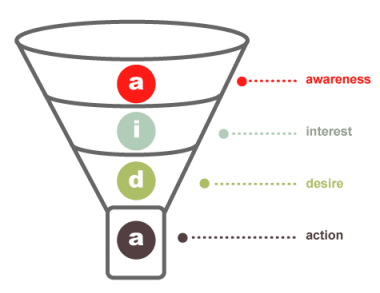At last week’s TMRE conference, BV Pradeep, Global Vice President, Consumer and Market Insights at Unilever presented on the topic of “Building Brand Equity – A New Paradigm for the New Connected World.”
He posited that the old rules of branding based on the AIDA model were no longer valid. Awareness, interest, desire and action in an inverted pyramid or a funnel:
The consumer journey has changed, and the pace of that change is accelerating. He presented a new trinity paradigm for marketing: understanding customers, communicating with customers, and selling to customers. The intersection of these three paths leads into one road towards successful customer engagement.
He then focused on the 7 new rules for branding in a connected world.
Rule 1: Purchase & authenticity are at the heart of a brand … The brand has to communicate its sense and meaning to the customer as well as the brand’s place in society. BV gave on example of Unilever showing support of the United Nations Global Goals. He then showed a touching video around Lifebuoy soap and their efforts to fight childhood mortality through hygiene awareness:
Rule 2: Understanding culture defines success … In Asian markets, the definition of beauty varies greatly. Attitudes toward beauty products cover the spectrum from “looks are God given” and must not be manipulated to “looks are my fortune” are must be optimized for their full benefit. A study of 7 million potential hair care and hair color product users were asked about changing their hair and over 4.3 million cast votes for “stay black.” As a result, hair color products are available to meet this unique market requirement.
Rule 3: From brand communication to conversion and customization … He showed a talking Clear Channel billboard at a Zurich train station interacting with passersby, inviting them to visit the nearby mountain resort of Graubunden. The billboard would print tickets for users engaged in a dialogue, and even called a teacher and a supervisor to explain that the student and the employee were taking a little time to get away.
Rule 4: Brands as entertainers … We a the video of the French people seeing bottles of water and exercise bikes in front of a public building. As more people ride the bikes, music starts playing and an entertaining light display starts showing.
Rule 5: Touchpoint experience makes a real difference … Mr. Pradeep used the example of a Chinese company that sells laundry soap using a blue-skinned spokesperson to reinforce their blue image, which is locally associated with cleanliness.
Rule 6: Real-time agility underpinning success … Digital technology breaks the high entry barrier to success. As an example, companies can use real-time marketing like temperature-sensitive billboards, which present ice-cream ads when it’s hot and cocoa ads when it’s cold.
Rule 7: From understanding to owning consumers … The key is to push content, not product. Mr. Pradeep used the example of “all things hair,” which is Unilever sponsored content. He also shared an example of the Apple ecosystem, where a product purchase is a gateway to membership; if you exit the brand, you also exit the community and all of its positive associations.
While we can’t all scale like Unilever, we can adapt to the new 7 rules of branding.
